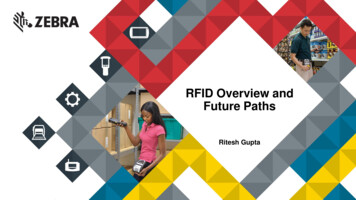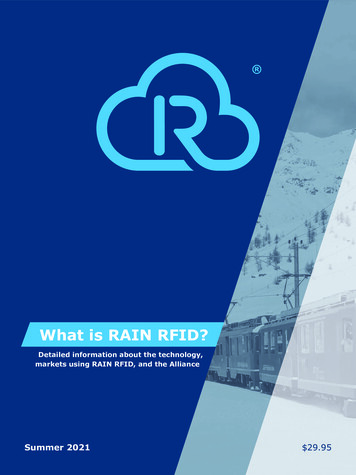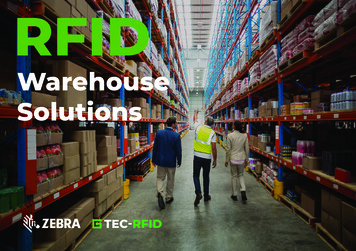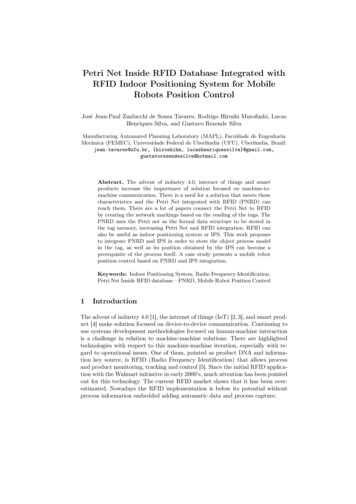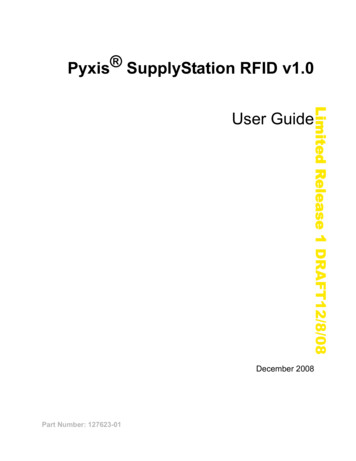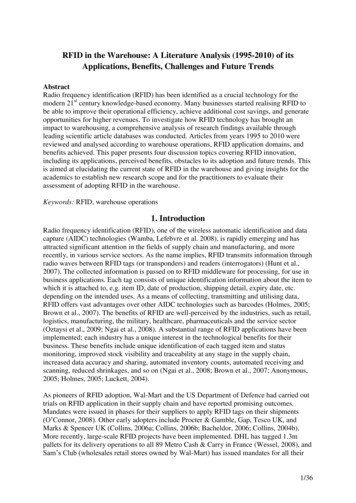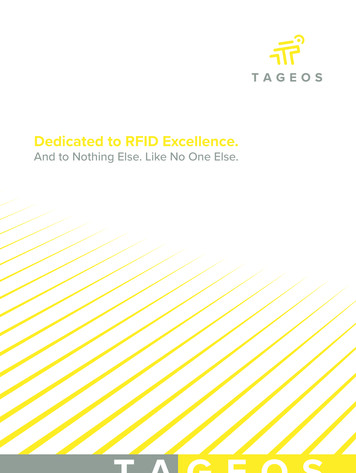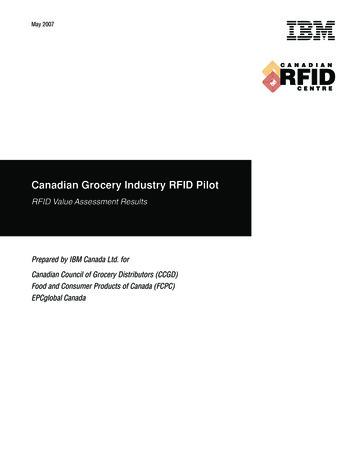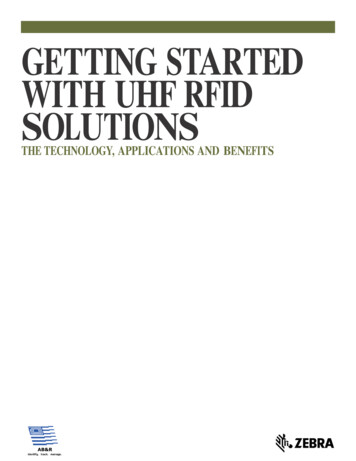
Transcription
GETTING STARTEDWITH UHF RFIDSOLUTIONSTHE TECHNOLOGY, APPLICATIONS AND BENEFITS
WITH RFID, YOU GETCONSTANT AND EFFORTFREE IDENTIFICATION,LOCATION AND TRACKINGINFORMATION. VISIBILITYINTO THE INVENTORY ANDMOVEMENT OF ASSETSAND PRODUCTS IS CRITICALBUSINESS INTELLIGENCE.
WHITE PAPERGE T TING STARTED WITH UHF RFID SOLUTIONSTHE CHALLENGE: BETTER VISIBILITYYour margins and profitability are under more pressure than ever before. Shaving time out ofbusiness processes has become a constant quest — the ability to get more done in less timewill ultimately reduce costs and strengthen the bottom line. Virtually every business spendsan inordinate amount of time on the same initiative — obtaining the supply chain and assetvisibility required to better manage the business. And no matter what industry you are in,chances are this effort is a tremendously time-consuming, manual and error-prone activitythat slows down the speed at which your business operates — and adds to the cost of doingbusiness. RFID is helping organizations across industries all over the world address theseissues by automating product visibility and asset management processes. With the power ofRFID, your products and assets practically manage themselves, providing constant and effortfree identification, location and tracking information.THE RFID SWEET SPOT:EFFORTLESS TRACKING OFEVERY PRODUCT OR ASSET,EVERY MOMENT OF THE DAYRadio Frequency Identification (RFID) is a championat providing real-time inventory, supply chain andasset management visibility, all with little or nohuman intervention. The real-time visibility improvesoperations, stripping time and errors out of youreveryday processes — from inventory, shipping andreceiving logistics to intelligent asset management. AndRFID is so versatile, you can find it at work in practicallyevery industry, helping: Distribution centers track shipments as theymove in, out and through the warehouse Retail stores perform more efficient cyclecounting and inventory operations Hospitals ensure that all defibrillators andother critical equipment are in stock and inthe right locations Manufacturers ensure raw material availabilityand optimize sequencing processesThis affordable, near instant and constant visibilityturns into big business benefits. Fewer errors, increasedautomation and a more efficient labor pool reduce costsand optimize business processes, allowing you to betterserve more customers — increasing sales and profitability.How does it work? When RFID tags that contain aunique serialized EPC code are placed on items andassets, the information can be automatically, wirelesslyand simultaneously captured with a fixed, handheldor mobile RFID reader. Hundreds of hours previouslyspent managing items are drastically reduced, yet youknow where each and every item is, all the time —from inventory to returnable transport items (RTIs) toequipment, tools and back-up tapes.RFID AND OTHER IDENTIFICATIONAND LOCATIONING TECHNOLOGIESThere are a number of radio frequency technologies thatare being used today to provide increased visibility intogoods and assets. The most commonly used include: LF (Low Frequency) HF (High Frequency) UHF (Ultra High Frequency) Wi-Fi Locationing NFC (Near Field Communications) Ultra Wide Band (UWB).and others.Most of these utilize a defined band in the radio frequencyspectrum that results in different operational andperformance characteristics, which in turn affects readrange, cost and deployment requirements. In addition,the technologies are not mutually exclusive. Dependingupon your supply chain and asset visibility requirements,you may wish to deploy multiple RFID technologies.Read range can be extended in some of the technologiesthrough the use of battery-assisted RFID tags. However,because of the battery cost, the longer read rangecomes with an increased cost per tag. As a result,battery assist technologies are typically utilized forhigher-value items that warrant precise monitoring andlocationing information.PAGE 3
WHITE PAPERGE T TING STARTED WITH UHF RFID SOLUTIONSThe frequency characteristics also define whichapplications are best suited for each technology. Forexample, NFC has become the defacto standard forticketing and payment because of its short read rangeand established payment protocols. Alternatively,the long read ranges and low tag costs in the UHFfrequency are ideal for inventory, supply chain and assetmanagement visibility.UHF TAG TECHNOLOGY MAKES RFIDAN AFFORDABLE REALITYasset. The result is a rapid return on investment (ROI) inas little as six months to a year — even for the largestof organizations.A LOOK AT UHF RFID IN ACTIONUHF RFID brings value to virtually any business that hasbulk items to manage — from product moving through thesupply chain to inventory to equipment. In the followingpages, you can see the benefits of UHF RFID solutions in:Today’s Gen 2 UHF RFID tags make RFID an affordablereality. Unlike active tags, these passive tags do notrequire their own power source — the reader providesthe power to initiate the transmission of data. Sinceless technology is required in the tag, their cost isvery low. A low cost RFID tag means you can tag andincrease visibility into more of the goods, products andassets which drive your revenue stream. The tags canbe re-used, easily updated with new data. And sincethese tags can be read from near contact to as far as30 feet away,1 you can use them on nearly any type ofINDUSTRIESHORIZONTAL APPLICATIONS Retail Asset Management Distribution and Warehousing IT Asset Management Manufacturing Returnable TransportItems (RTIs) Government Energy: Utilities, Oil and Gas Healthcare Track and Trace:Cold Chain/Food SafetyHOW IT WORKS: THE UHF RFID COMMUNICATION LOOPRFID READERS1RFID INLAYRFID IC (RFID CHIP)RFID READERS to RFID TAGSThe antenna on the RFID readerbroadcasts electromagnetic energy2FIXEDRFID ANTENNA83643 2678319 285912BD83920 2093H809 089A2783436783 H88392MOBILERFID TAGS to RFID READERSThe electromagnetic energy ‘wakes up’the tag. The tag then either harvestspower from the RFID reader (Passiveand Semi-Active) or utilizes power fromits internal battery (Active) to respondby sending the data on the tag over theelectromagnetic radio waves backto the readerRFID TAGSERVERS323827 1253BCAZ 78390278049 356782J3678455Z7RFID READERS to SERVERSHANDHELDThe reader receives the radio waves,interprets the data and passes it to theappropriate business applicationBackend Computer ApplicationsPAGE 4
WHITE PAPERGE T TING STARTED WITH UHF RFID SOLUTIONS IN YOUR INDUSTRYRETAILDISTRIBUTION ANDWAREHOUSINGRetailers need detailed inventory information to keepthe right items on the shelves of the store. But manualcycle counts are too costly to be performed frequentlyenough to provide current information. UHF RFID’sconstant and accurate inventory information providesvisibility into inventory levels, allowing retailers tomake sure that customers find the products theywant to purchase on the store shelves. And since theinformation is collected automatically, sales associatescan spend more time with your customers — instead ofmanaging inventory.In the distribution industry, profitability is tightly tiedto how fast and accurately inventory moves in, throughand out of the warehouse. With UHF RFID, warehouseworkers have the visibility they need to processthousands or hundreds of thousands of items every day,as fast and accurately as possible.APPLICATIONS Returnable Transport Item (RTI) management Inventory and cycle counting Inventory Receiving Replenishment Item locating Loss detection/prevention Demand forecastingBENEFITS Achieve near 100% inventory accuracy 2 Maintain real time inventory information —without any labor costs Reduce out of stocks by as much as 80 percent 2APPLICATIONS Shipping and receiving Put-away and picking Cross-dockingBENEFITS Achieve near-100 percent order and shipping accuracy 2 Process orders up to 40 percent faster 2 Improve workforce efficiency — reduce labor costsup to 30 percent 2 Improve inventory turns Automate advanced shipping notice (ASN) deliveryand receipt Improve customer and trading partner satisfactionby delivering the right items on time, every time Minimize markdowns Reduce inventory carrying costs by as muchas 59 percent 2 Increase associate efficiency — associates arefree to spend more time serving customers Increase sales by as much as 14 percent 2PAGE 5
WHITE PAPERGE T TING STARTED WITH UHF RFID SOLUTIONSUHF RFID AND PRIVACYWhile the advantages of RFID are clear, privacy andsecurity will be a concern not only for you, but alsofor your customers. Regardless of what type of UHFapplication you need, you can count on your dataremaining secure.Security in inventory, supply chain andasset management applicationsMANUFACTURINGUHF RFID tags are typically utilized to identify productand goods on the retail floor or in the supply chain, orassets utilized to conduct business — from IT assets tomaterial handling equipment in the warehouse ormachinery on a production line. The Electronic ProductCode (EPC) or asset number that is stored on an RFIDtag typically contains product and stocking informationonly — data that is not sensitive. Just like a bar code,the data may correlate to sensitive information thatresides on a secured and encrypted back office database.Even if an unauthorized user gained access to the RFIDtag data, the information would be a meaningless stringof numbers, with no context.For manufacturers, success hinges on the speed andaccuracy of their manufacturing operations. UHF RFIDprovides instant and accurate tracking of informationat every step inside the manufacturing plant, trimmingwasted time and costs out of end-to-end manufacturingprocesses — from receipt of raw goods to RFIDenabling supply, sequencing, assembly and shippingof final product. The net result is a leaner and moreprofitable manufacturing operation.To further guard against unauthorized access,transmissions between RFID readers and tags canalso be protected by encryption and authenticationprotocols. RFID Generation-2 and ISO 18000-6standards (most often used for RFID in retail settings)offer enhanced security. You can now add passwordsto individual tags to prevent impermissible copying,much like the additional protection a personalidentification number (PIN) provides when paying forgoods with a credit or debit card. Line sequencing, raw material supplySecurity in identity management and credentialingAPPLICATIONS End-to-end warehouse operations Quality assurance E-Kanban/replenishment Work-in-Process (WIP)/Just in time (JIT)BENEFITS Improve global inventory accuracy — from rawto finished goods Improve product quality with increased automationof process and materials visibility Increase shipping and receiving accuracySince RFID tags are nearly impossible to forge, justtheir mere presence can increase the security ofsensitive documents, such as passports or agencyID cards. An integrated RFID tag can play a valuablerole in preventing fraud and the counterfeiting ofgovernment-issued identification documents,helping thwart unauthorized personnel fromentering a country or a government agency.PAGE 6
WHITE PAPERGE T TING STARTED WITH UHF RFID SOLUTIONSGOVERNMENTENERGY: UTILITIES, OIL AND GASUHF RFID helps federal, state, local and municipalgovernments find ways to better manage budget cutsby improving visibility into more timely information aswell as the location of assets and items in the supplychain. Access to instant and accurate information canhelp government agencies keep city infrastructure andmilitary equipment in good working order; reach disastervictims faster; execute more timely and accuratebuilding code and health inspections; and more. Theresult is the more efficient delivery of higher qualityservices, improving citizen safety and satisfaction.In the energy industries, the cost of unplanneddowntime can be devastating to profitability. UHF RFIDprovides the constant visibility into the location ofeverything required to keep production plants up andrunning. Automatic and accurate tracking of everythingfrom materials and equipment to onshore and offshorepersonnel as well as emissions and equipmentmaintenance schedules allows energy producers toincrease plant uptime, better protect employees andreduce the cost of compliance with strict environmentaland security regulations.APPLICATIONSAPPLICATIONS Supply chain logistics Industrial asset management Identity management/credentialing Operator rounds Asset management Employee safety Data center asset management AMI - Automated Metering Infrastructure Inspections and code enforcement Plant security Maintenance and repair Accurate in-the-field inventory Disaster managementBENEFITSBENEFITS Increase productivity and production uptime Improve the delivery of government services,assets and goods through increased shippingand in-transit visibility Real-time access to asset maintenanceand condition records Improve the productivity of government workersby automating manual processes More efficient and cost-effective regulatory reporting Improve the security of government assets andworkers with real-time location information Increase asset utilization Improve worker safety by ensuring any necessaryevacuations are complete Reduce the total cost of ownership of equipmentthrough timely maintenance and better asset utilization Improve the speed and quality of citizen servicesPAGE 7
WHITE PAPERGE T TING STARTED WITH UHF RFID SOLUTIONSUHF RFID TECHNOLOGY: THE BASICSRadio-frequency identification (RFID) technology usesradio waves to exchange identification and tracking databetween an RFID reader and an electronic RFID tag thatis attached to an object, such as a shipment of products,a forklift in a warehouse or even an employee badge. Amicrochip in the RFID tag contains the data. In read-onlytags, the data can only be captured. In read-write tags,the data can be captured, new data can be appendedto the existing data set or new data can completelyoverwrite the existing information on the tag. Theantenna on the RFID reader enables the communicationbetween the tag and reader. The distance that anRFID tag can be read depends on a number of factors,including the environment, as well as the size and typeof RFID tag.Ultra High Frequency (UHF) RFID is especially excitingto the business world because it offers long read rangeswith low cost RFID tags, allowing organizations to tagand automatically track large quantities of goods andassets. Typical read ranges for UHF passive tags are8 to 30 feet (2.4 m to 9.14 m) and beyond.Unique RFID characteristics No line of sight required Read many tags simultaneously Re-usable tags — read and write datato low-cost, flexible tags Rich data capacity Durability Difficult to replicate, reducing opportunitiesto introduce a counterfeited productRFID reader types Fixed RFID readers automate data capture at keyentry and exit points, such as building entrances orthe door to the IT data center, and typically requireexternal antennas to either sides of the portal.PAGE 8RFID READERS Handheld RFID readers allow on-the-spot readingof RFID tags, allowing workers to perform quick andaccurate inventories or search for specific items on awarehouse shelf or in a store dressing room. Mobile RFID readers can either:– perform as fixed RFID readers in temporary andhard-to-install locations– be affixed to a cart and wheeled through awarehouse, IT data center or retail sales floorfor quick and easy inventory takesFIXEDINDUSTRIAL-CLASSMotorola FX9500– be used on forklifts to read every pallet and itscontents, whenever the pallet is moved Presentation RFID readers are ideal whereverworkers or customers need to present RFID-enableditems to the reader — for example, at the retail pointof sale (POS), an asset management commissioningstation or at an entry point (for example an airportgate or event entry point)FIXEDBUSINESS-CLASSMotorola FX7400What application characteristics createan ideal scenario for RFID technology?RFID is the ideal data capture technology when you: Need to track a large amount of unique product SKUs— such as a multitude of sizes, styles and colors Have high-value items to track Need to routinely move a high volume of items in alimited time period, for example for retail promotionsor short seasonal retail windowsFIXEDINDUSTRIAL-CLASSMotorola MC9190-Z Have reusable assets that have a determined orcircular supply chain — such as returnable transportitems like bins, totes, trolleys and carts Need a more automated process to track and traceitems to meet government regulations and ensuretimely asset availabilityFIXEDBUSINESS-CLASSMotorola MC3190-ZPRESENTATIONMotorola DS9808-R
WHITE PAPERGE T TING STARTED WITH UHF RFID SOLUTIONSHEALTHCARETRANSPORTATION/AVIATIONUHF RFID provides hospitals with a constant windowinto the location of medical equipment, medicalsupplies, critical documents and even patients —without any human effort. The result is a new level ofefficiency and accuracy in every day processes thatdrives productivity, patient safety and care quality up— and costs down.In the airlines industry, a single incidence of lost ordelayed luggage can mean the loss of a long timeloyal customer as well as additional costs that pressuremargins that are already razor thin. But UHF RFID-enabledluggage tags allow airlines to ensure that the right bagis placed on the right plane every time. In addition, thetransportation industry is also using RFID to providesupply chain visibility and ensure maintenance andrepair are performed properly and on time.APPLICATIONS Asset tracking Inventory management Identity and access management Document and folder tracking Patient location trackingBENEFITSAPPLICATIONS Baggage sorting and routing Exception management (rapid identification ofbags that need to be removed for passengerswho are not on the plane) Maintenance, Repair and Overhaul (MRO) Reduce lost and stolen assets and equipmentBENEFITS Right-size supplies, spares, medical equipmentand instrument inventory Increase in baggage throughput up to 20 percent 2 Instantly locate needed medical suppliesand equipment Improve security and safety Ensure timely replenishment, eliminatingdangerous out-of-stocks Reduce labor costs Cost-effectively comply with security regulations Eliminate the many costs associated with a mis-handledbag — estimated at approximately 100 per bag 4PAGE 9
WHITE PAPERGE T TING STARTED WITH UHF RFID SOLUTIONS AND IN HORIZONTAL APPLICATIONSASSET MANAGEMENTIT ASSET MANAGEMENTUHF RFID streamlines the management of all types ofassets, from finished goods inventoried in yourwarehouse to production line equipment, tool and othercritical business assets. Less time is spent trackingand managing assets, and asset visibility is increased.And since maintenance takes place on time, assetuptime and longevity are protected, improving thereturn on asset (ROA).UHF RFID can track the thousands of IT assets that arecrucial to practically every business — from the servers,hard drives and tape backups required to warehousebusiness applications and data to the handheld mobilecomputers and laptops that provide employees withinstant access to information. You know where yourassets are, who has which asset at all times, with acomplete audit trail for every asset — all without anyhuman effort.APPLICATIONS Asset inventory, tracking and managementAPPLICATIONS Asset inspections, maintenance and repair IT asset inventory management, trackingand maintenance Mobile device asset managementBENEFITS Maximize asset lifecycle and improveasset utilization Minimize asset replacement costs Increase worker productivity Enable rapid and cost-effective inventory takesBENEFITS Improve utilization and visibility of ITasset inventories Encourage frequent and easy inventory takes byeliminating hard to access bar codes and othermanual asset identifiers Provide cost-effective ‘cradle-to-grave’real-time tracking Improve utilization of IT assets Prevent loss of IT assets Better protect and manage sensitive customer media Enable cost-effective compliance with regulationsthat protect consumer data, such as HIPA A inhealthcare and PCI in retail Reduce capital IT equipment costsPAGE10
WHITE PAPERGE T TING STARTED WITH UHF RFID SOLUTIONSRETURNABLE TRANSPORTITEMS (RTIS)TRACK AND TRACE: COLDCHAIN AND FOOD SAFETYWith UHF RFID tags on bread racks, plastic crates,rolling cages and many of the other types of RTIsrequired to move and deliver goods, businesses cantrack the location and status of RTIs no matter wherethey may be in the supply chain. Fewer spares arerequired, reducing the capital and operational costsassociated with purchasing and managing RTIs. Andfees for lost or damaged RTIs can be charged back tothe accountable party. RTI asset inventory, tracking and managementUHF RFID can automatically and accurately collect thewealth of information required to verify thattemperature-sensitive products were handled properlyduring the entire trip, from source to destination.The errors and delays in visibility that can occurwhen information is manually transcribed and thenentered into the computer are eliminated, improvingthe safety of the food, medicine, pharmaceuticalsand other temperature sensitive products travelingthrough the supply chain, reducing losses due tospoilage and enabling cost-effective compliancewith government regulations.BENEFITSAPPLICATIONS Reduce the annual RTI investment Cold and food chain asset condition tracking Reduce RTI shrinkage Cold and food chain track and traceAPPLICATIONS Recoup the cost of lost or damaged RTIs Reduce the size of the RTI asset pool andassociated storage costsBENEFITS Improve food safety and better protectconsumer goods Increase supply chain productivity through theelimination of paperwork Achieve cost-effective compliance with governmentsafety and track and trace regulations Reduce losses due to contamination and spoilage Enable rapid and more narrow product recalls Protect brand equityPAGE11
WHITE PAPERGE T TING STARTED WITH UHF RFID SOLUTIONSRFID FAQsWill RFID replace bar codes?RFID could eventually replace bar codes in someapplications where bulk counting is routinely performed.But as a rule, RFID and bar codes are not mutuallyexclusive — they each have their strengths andwill continue to exist side-by-side for many years tocome. The differences between the two data capturetechnologies include: Line of sight — a bar code scanner and bar codemust be visible to each other to enable a successfulscan, where RFID tags need only to be within a readrange to be read. Simultaneous tag capture — Bar codes are capturedone at a time, where RFID tags can be captured inbulk. Type of data — Bar codes can only hold static data,while RFID tags can be written and re-written asneeded.RFID limitations: does RFID work in the presenceof metal and water?Metal and water have traditionally affected RFID readperformance, but new engineering breakthroughs haveshown that issues created by metal and water can beovercome with good system design, specially designedRFID tags and proper tag placement.What is the dif ference between passive andactive tags?Active RFID tags have their own transmitter and powersource (generally a battery) utilized to power thecircuitry and broadcast the signal to the reader. Passivetags do not need a power source. Instead, they drawpower from the RFID reader.is in the 860-960 MHz range. Your application needswill drive the frequency that is right for your RFIDapplication. UHF tags work over a larger range andcan provide the longest read ranges of these threetechnologies. HF tags have a maximum read range ofroughly three feet (one meter). LF tags have the shortestread range (less than a foot/0.33 meter).What is the EPCIS standard and why is it important?EPCIS is a common interface that allows supply chainpartners to easily share and exchange EPC-relatedinformation. Integration between different enterprisecomputer systems and applications is greatly simplifiedwith EPCIS. Supply chain partners can confidently sharedata, yet retain ownership of their data, able to ensureits security.What is the EPC Gen 2 standard and whyis it impor tant?The EPC Gen 2 standard is a set of global standardsthat enables international compatibility as well asfeatures that improve RFID performance. For example,dense reader mode is a Gen 2 feature that preventsinterference and duplicate reading when readers areplaced in close proximity.Do RFID and its associated radio wavespose any health risks? 3RFID Journal, one of the preeminent sources of RFIDinformation, states that “The World Health Organization’sresearch, as well as many other scientific studies, haveshown that EMF exposure below the limits recommendedin internationally adopted guidelines has not revealedany known negative health effects.” Readers and activetags are low power devices that emit very little RFenergy. (For more information on potential health issues,visit w w w.r fidjournal.com)What is the dif ference between LF, HF and UHFRFID technology?Low frequency (LF) is tuned to 125 KHz, high frequency(HF)is tuned to 13.56 MHz, and ultra high frequency (UHF)PAGE12
WHITE PAPERGE T TING STARTED WITH UHF RFID SOLUTIONSRFID GLOSSARYActive tag: An RFID tag that has a batter y that powers thecircuitr y and transmits the signal to a reader. Active tags canbe read from 100 feet away or more and are used for trackingexpensive items over long ranges.EPCglobal: The non-profit organization that manages standardsand numbering schemes associated with EPC and the successororganization to the Auto ID Center. EPCglobal is a membershipdriven organization and is a subsidiar y of theAntenna: The element built into both RFID readers and tags thatradiates and receives radio energy.European Ar ticle Numbering (E AN): The bar codestandard used throughout Europe, Asia and South America.It is administered by E AN International.Automatic identification (also called automatic data capture):The ability to collect and enter data directly into computer systemswithout human involvement through technologies such as barcodes, biometrics, RFID and voice recognition.Excite: The reader is said to “excite” a passive tag when thereader transmits RF energy to wake up the tag and enable it totransmit back.Backscat ter: A method of communication where tags reflectback a por tion of the radio waves that are emitted by the readerto transmit tag data to the reader.Frequency: The number of repetitions of a complete wave withinone second. 1 Hz equals one complete waveform in one second.1 KHz equals 1,000 waves in a second.Bat ter y-assisted tag: These RFID tags contain batteries thatprovide direct power on the tag itself to increase read range(sometimes called “semi-passive RFID tags.”)GTAG (Global Tag): A standardization initiative of the UniformCode Council (UCC) and the European Ar ticle NumberingAssociation (E AN) for asset tracking and logistics based on radiofrequency identification (RFID). The GTAG initiative is suppor tedby NXP, Intermec, and Gemplus — three major RFIDtag manufacturers.Circular-polarized antenna: This omnidirectional UHF readerantenna emits radio waves in a circular pattern and is designedto easily capture RFID tags that are presented in differentorientations.Contactless smar t card: A credit or loyalt y card that containsan RFID chip that can automatically transmit information to areader — no ‘swiping’ required. Such cards can speed checkout,providing consumers with more convenience.Chipless RFID tag: An RFID tag without an integrated microchip.Materials in the tag reflect back a por tion of the radio wavesbeamed at them from the reader. The waveforms are utilizedmuch like a fingerprint to identif y the object that is tagged.Although chipless tags are inexpensive, they are not useful in thesupply chain since they cannot transmit a unique serial numberthat can be stored in a database.Closed-loop systems: RFID tracking systems set up within acompany, where there is no data sharing with other companiesrequired to enable the application. One example is a railroad thatissues its own RFID-enabled tickets.Die: The silicon block onto which circuits have been etched.Electromagnetic inter ference (EMI): Inter ference causedwhen the radio waves of one device distor t the waves of another.Cells phones, wireless computers and even robots in factories canproduce radio waves that inter fere with RFID tags.GTIN (Global Trade Item Number): A GTIN is a GS1identification key that enables global identification of an itemany where in the supply chain. No matter in the supply chain anitem may be — from manufacturer to distributor to retail storeto end consumer — a scan of the GTIN enables any par tner in agiven supply chain to accurately identif y the product and obtainpricing. The result is highly ef ficient ordering and invoicing acrossthe supply chain.Har vesting: A term that describes how passive tags gatherenergy from an RFID reader antenna.High-frequency (HF) tags: HF tags t ypically operate at13.56 MHz and can be read from about 10 feet away. They transmitdata faster, but consume more power than low-frequency tags.Integrated circuit (IC): A microelectronic semiconductordevice comprising many interconnected transistors and othercomponents. Most RFID tags have ICs.Inter ference: Any thing that prevents radio waves from travelingbet ween a tag and reader correctly and causes the tag to be readincorrectly. Can be caused by other radio signals or by some physicalobjects metals and liquids that absorb or reflect the radio signals.Interrogator: See RFID reader.Electronic ar ticle sur veillance (E AS): Simple electronictags that can be turned on or off. When an item is purchased orborrowed, the tag is turned off. When the item passes a gatewith a
A LOOK AT UHF RFID IN ACTION UHF RFID brings value to virtually any business that has bulk items to manage — from product moving through the supply chain to inventory to equipment. In the following pages, you can see the benefits of UHF RFID solutions in: Today's Gen 2 UHF RFID tags make RFID an affordable reality.

